Living with Cougars on the Olympic Peninsula
Air Date: Week of October 6, 2023
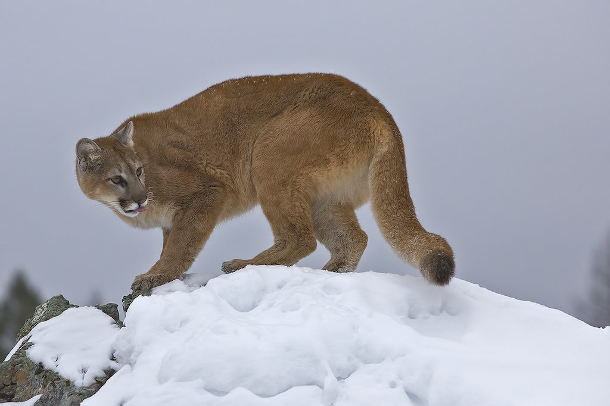
Cougars are also known as mountain lions, pumas, panthers, and catamounts. (Photo: Elaine R. Wilson, Wikimedia Commons, CC BY-SA 3.0)
When a cougar on the Olympic Peninsula in Washington State makes a meal out of someone’s goat or chicken, it can end up with a bounty on its head. But there are non-lethal methods to deter cougars from taking livestock and pets. Liza Gross of Inside Climate News joins Host Aynsley O’Neill to discuss.
Transcript
O’NEILL: The Olympic Peninsula in Washington State is a lush temperate rainforest that’s attracting newcomers from the rest of the Pacific Northwest. But many don’t realize they’re moving into cougar territory. The big cats, which are also known as mountain lions and panthers, are plenty at home on the peninsula already. And in some cases that’s leading to tragedy for pet and livestock owners and the cougars themselves. Liza Gross reported on this for our media partner Inside Climate News. Liza, welcome to Living on Earth!
GROSS: Thank you so much. It's great to be here.
O'NEILL: You write that researchers with the Olympic Cougar Project put collars on cougars to study them. But the cougars just kept dying. What was going on there?
GROSS: So the original idea of this project was to understand the biology and the ecology of these animals. They're wide ranging carnivores, they basically have a huge territory, and especially the young dispersers go out and they try to find homes. But what happens is, because there's a lot of development that's been happening, and more and more people are moving to the Olympic Peninsula, the cats keep winding up dead. And the cats keep winding up dead because they happen upon somebody's goat or somebody's llama that's being raised sort of out in the middle of the woods without being protected. And so a cat see something that looks like prey, it's going to take that animal.
O'NEILL: There's one particular story I want to hear more about. Tell us what happened when a cougar came in contact with the Frey family.

One of the kittens of a mountain lion named Scalp hides in the mossy fallen timber of the big cats' den in forest reserved for timber harvests on the Olympic Peninsula of Washington. (Photo: Michael Kodas)
GROSS: That was actually an unbelievably, remarkably unlucky series of events. So the family actually had a really amazing enclosure for their animals. They had goats, they had chickens, they had geese. It had a roof, it had a totally enclosed fence. But the problem is that enclosure was attached to a shed that had a solar operated door. And what happens is, it was almost like a Rube Goldberg kind of thing, a cougar walked by, there was a motion activated light that was right next to the solar panel shed door, and a cougar walked by, triggered the motion operated light, which opened the solar power door. And this is what one of the experts thinks happened. One of the cats peeked their head in the door, tried to see if they could get inside, then realized they could, wiggled in, and then chaos ensued.
O'NEILL: And what did the family end up losing?
GROSS: It's very sad, they had brought two geese with them from their home in Texas and the geese had sort of been alarm animals sort of, you know, for their chickens, which they had back there as well. And the geese stood up to defend the chickens and the cougar killed them right away. And then several chickens were killed that time. But unfortunately, after that, the family had a habit of sort of walking their goats and letting them free range and whatnot, and let their chickens out. And the same young cougar came by and took one of the goats and several more chickens, which is very sad.
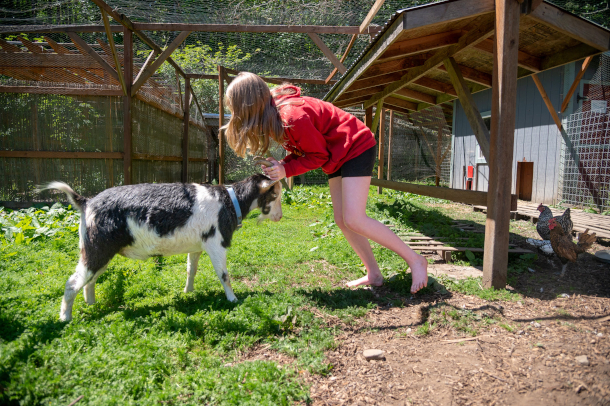
Haddie Frey, 12, wrestles with Flick, a Nigerian dwarf goat that is one of the many animals the family keeps on their property west of Port Angeles on Washington's Olympic Peninsula. The family, which moved to Washington from Austin, Texas, has lost a number of their animals to a mountain lion. (Photo: Michael Kodas)
O'NEILL: How did the family respond to that?
GROSS: They were horrified and very upset. But sadly, they didn't really know who to call or what to do; they were sort of new to the area, they'd come from Texas, and they just sort of watched helplessly. So they didn't know what to do, actually, but their first reaction was not to kill the cat, their first reaction was try to figure out what to do about it, and how to protect their animals. It's really kind of touching because the family really loves animals. And that's why they actually had all these farm animals that they kept more as pets than as you know, money making operation; their chickens, they didn't even sell the eggs with their chickens, they were sort of pets. And what was actually pretty neat about how the Olympic Cougar Project operates, for people who have interactions with the big cats, they offer to come out on a capture with them. And that's sort of a way to educate people to sort of see how these large carnivores operate on the landscape. And actually, it's pretty interesting to see that they're afraid of dogs, just like your house cat might be. And so they have trained hounds, which go on to the scent of the cat, you know, they follow the scent of the cat. And then, they call it "tree" it, they basically chase it up a tree, where the cat's, you know, not very happy about being up there. But when the experts come, the biologists and the team technicians come, they shoot a tranquilizer dart at the cat and it takes a little while for that to take effect. And then they bring the cat down and they put a collar on it so they can study it later.

Olympic Cougar Project co-director Mark Elbroch looks over a cougar kitten moments after it was pulled out of its den during a visit to give the cubs medical checkups and install chips in them. (Photo: Michael Kodas)
O'NEILL: But the sad fact is, it doesn't always end quite so humanely.
GROSS: That's absolutely right. So what usually happens is a landowner will call the state and the state wildlife agency which is the Washington Department of Fish and Wildlife. They're basically called wardens who respond to this kind of an incident. And almost invariably, if they find the cat, they shoot the cat, and that's the way they respond. The Olympic Cougar project has a different response. Panthera is an international wildcat conservation and research organization. They do not have the authority the legal right to go in and capture and tree or relocate the cat, but they work with six tribes that operate on the Olympic Peninsula and they have sovereign authority to do what they would like to do as sovereign nations. And so the call is usually not to kill the cat, but to tree the cat, capture it, study it.
O'NEILL: I have to wonder, how effective is lethal control of cougars? If a cougar puts a toe out of line, it could end up with deadly consequences for it. But is that even something that makes sense in the end?
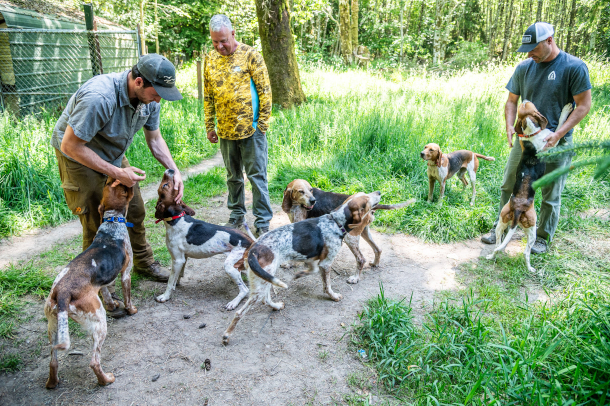
Greg Jones, center, keeps red tick hounds, which he uses to track and tree cougars both for Washington State authorities and for the Olympic Cougar Project. (Photo: Michael Kodas)
GROSS: That's a very good question. And one of the leads in the Olympic Cougar Project, his name is Mark Elbroch, and he's a lion expert who's studied these big cats: cougars, also known as mountain lions, and many, many other names. And he did a literature review to see, does it actually work? If you kill a big cat that's been accused of taking somebody's goat or a llama, does it actually reduce what's called depredation, which is basically the taking of a small farm animal. And he couldn't find any real evidence to show it actually works. And part of the reason is because these animals are opportunistic. And what that means is, they basically prey on things, if they're hungry, that walk in front of them, or that they encounter in their habitat. And so if you kill one cat that happened upon a little goat, that doesn't mean it's going to stop another cat from doing that. And so that raises the issue of what you should be doing.
O'NEILL: And not everybody will necessarily have it in their mind to call the Olympic Cougar Project. But what can people do sort of at the personal level, at the home level, to reduce cougar--human conflict?
GROSS: There are a lot of things, actually, that can be done, starting with just getting a livestock guardian dog, these really large dogs that the cats are afraid of, just like any cat. So this is sort of a Great Pyrenees breed, or a Kangal, or an Anatolian shepherd. And these are the same dogs that shepherds in the Pyrenees have used for years against the brown bears, also known as grizzly bears that they have in France and Spain. And that's one thing that's relatively easy. Other things require more money. These are things like getting enclosures that have a roof, so really good fences that have a roof because cougars can jump at least 15 feet.
O'NEILL: Wow.
GROSS: So if you have a fence that keeps your goat in, it's not going to keep a cougar out. So that's a very important thing to do. Then they also try things like hazing, so shooting rubber bullets at a cat if it seems to be a young cat that just keeps coming back to the property. And then finally, what's really important is for people to stop feeding deer, people actually feed deer, like leaving, you know, apples and this and that and the other thing, and then also cleaning up their garbage so they don't attract raccoons, because raccoons are a pretty steady source of food for the young cats, who are still learning how to take down the bigger prey.
O'NEILL: So we've been talking about this really great program with the Olympic Cougar Project. But they're not the only ones in charge of what happens with cougars. What if anything is happening to find non lethal solutions with the Washington Department of Fish and Wildlife?
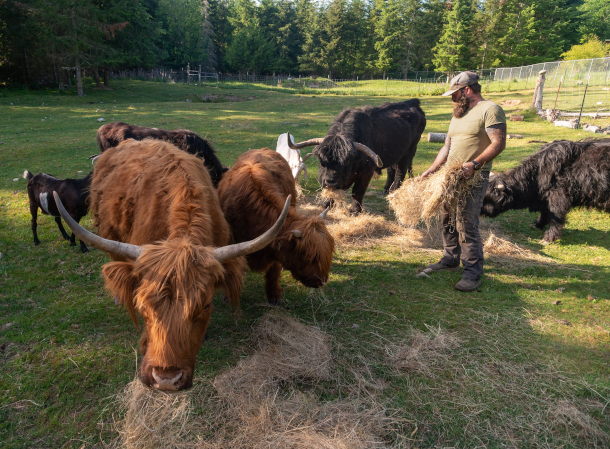
Matt Mayhen has a farm off the grid on Washington's Olympic Peninsula. He's lost livestock to the cougars that roam the dense woods that surround his property and has accompanied Olympic Cougar Project teams to track down cats that were problems for him, which led him to try to operate his farm in a way that allowed the mountain lions to coexist with his family and animals. He's started raising Scottish highland cattle because they are less likely to be preyed on by cougars and can fend them off. (Photo: Michael Kodas)
GROSS: Well, the agency held what they called a cougar focus group last year to solicit input for how to deal with this conflict situation, because they recognize that more people are moving to the area and more conflict is happening. And so they got what they called stakeholders, a variety of people from livestock scientists, houndsmen, who's got a lot of experience with understanding the biology of the cats and how they act. And they got a ton of suggestions. And everybody sort of agreed that they needed to find ways to avoid this lethal removal, which basically is killing the cat whenever a landowner complains that a cat has taken its livestock. There hasn't been much action yet. I mean, the agency has a "living with cougars" pamphlet. But people don't necessarily know about that. And I think that as with most agencies, when you're dealing with the public, there's a problem of staffing and resourcing. And so I think people are still waiting to see what the agency is going to do.
O'NEILL: But I believe there are some signs of hope with a new generation that's being born. And you went out with some of the biologists from the Olympic Cougar Project in search of a cougar den. Can you tell us about what that was like?
GROSS: Well, that was pretty amazing, I have to say. Number one, it was amazing that they were actually able to find the den. And here's the surprising tidbit. The den was in the middle of a timber forest. So it was an active timber forest where you could hear chainsaws whirring in the background, and I was thinking, this doesn't seem good. But surprisingly, the biologists were explaining to me that the timber forests actually almost serve as a refuge for these cats, because they cycle through, so there are decades where the forest isn't being harvested by the lumber companies. And actually, the biologists have a pretty good relationship with the lumber companies who recognize, well, maybe if there's a den there, maybe we won't go in there. We'll work around it. So that hasn't been the biggest issue. The other thing is because it's an actively harvested area, they do a lot of thinning beforehand. So what that means is they're trying to get the other trees to grow bigger, but they leave all this brush behind, and it's just so thick and it's sort of like the best place to stash your kittens, I think, because who could find them? [LAUGHS]
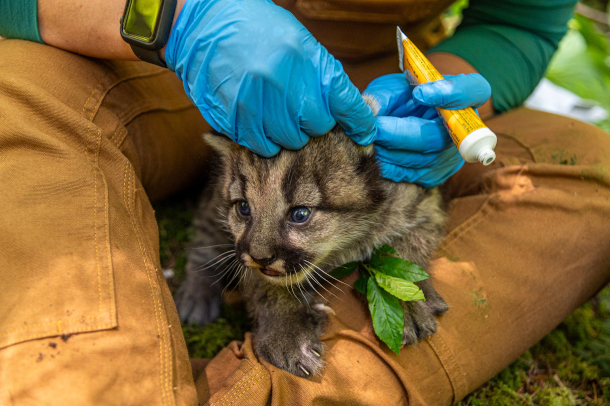
Caitlin Kupar of the Olympic Cougar Project inserted a cougar kitten with a chip and gave it a medical exam while visiting its den on the Olympic Peninsula in June, 2023. (Photo: Michael Kodas)
O'NEILL: And could you tell us a little bit more about the family in this cougar den?
GROSS: Yes, there was a girl and a boy, just three weeks old. And this family carries special meaning for the team. And that's because their mother, Scalp, had surprised everybody by surviving after the state actually made her an orphan at just 10 months old. It's very unusual for young cougars of a year old even to make it on their own, because they can stay with their moms up to 18 months to learn how to take down deer and hunt on their own. And her mother had been killed for taking somebody's goats, a couple goats, and left her an orphan. Yet she managed to make it, and then she seemed to have been one of the youngest cougar mothers that they ever documented. But they named her Scalp because one of the team, Andy Stratton, sedated her and as Andy was trying to retrieve her from the tree, her paw swung around and nicked him on the scalp. And so that was sort of a badge of honor for him. And that's how they named that cat.
O'NEILL: It's incredible to hear about this den, this like quasi-sanctuary within the world of not just the chainsaws cutting down trees, but also the wider world of antagonistic humans. How were the kittens when you found them?
GROSS: Well, it was really amazing to see how delighted the biologists were when they found them, because they've seen all sorts of things. They've gone to dens where the kittens were dead. They've seen very unhealthy kittens. And they were just literally delighted to say, Oh, look at, they're so dark, which is really helpful for camouflage. So they had all these dark spots all over them, which helps you not be able to see them if you happen upon them in this incredibly, you know, dense pile of branches. And they also just seemed full of milk, is what they kept saying, that mama is doing a really good job of taking care of them, because not all cats are as good at taking care of their kittens as the other ones. And the two kittens, even though they were only three weeks old, they had razor sharp claws, their claws were definitely out there and growing. Their teeth were just coming in but the claws were pretty sharp.
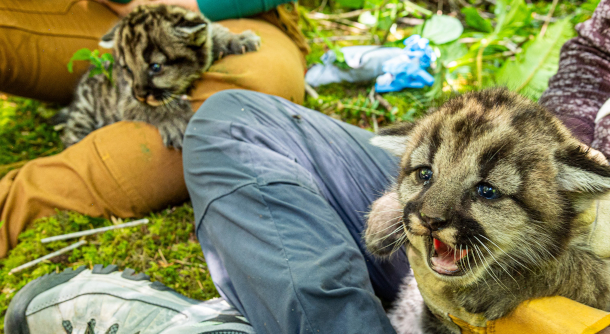
Cougar kittens being examined and chipped outside their den on Washington State's Olympic Peninsula in June, 2023. (Photo: Michael Kodas)
O'NEILL: Wow.
GROSS: I can tell you from experience -- one caught my arm a tiny little bit, a little piece of blood came out but I sort of felt, as a souvenir. So it was, it was quite the experience.
O'NEILL: That was also a badge of honor, huh?
GROSS: It was pretty exciting to be nicked by a little cougar kitten, I have to say! [LAUGHS] Wasn't much damage. [LAUGHS]
O'NEILL: Liza Gross is a reporter for our media partner Inside Climate News. Liza, thank you for taking the time with me today.
GROSS: Thank you so much for having me.
Links
Living on Earth wants to hear from you!
Living on Earth
62 Calef Highway, Suite 212
Lee, NH 03861
Telephone: 617-287-4121
E-mail: comments@loe.org
Newsletter [Click here]
Donate to Living on Earth!
Living on Earth is an independent media program and relies entirely on contributions from listeners and institutions supporting public service. Please donate now to preserve an independent environmental voice.
NewsletterLiving on Earth offers a weekly delivery of the show's rundown to your mailbox. Sign up for our newsletter today!
 Sailors For The Sea: Be the change you want to sea.
Sailors For The Sea: Be the change you want to sea.
 The Grantham Foundation for the Protection of the Environment: Committed to protecting and improving the health of the global environment.
The Grantham Foundation for the Protection of the Environment: Committed to protecting and improving the health of the global environment.
 Contribute to Living on Earth and receive, as our gift to you, an archival print of one of Mark Seth Lender's extraordinary wildlife photographs. Follow the link to see Mark's current collection of photographs.
Contribute to Living on Earth and receive, as our gift to you, an archival print of one of Mark Seth Lender's extraordinary wildlife photographs. Follow the link to see Mark's current collection of photographs.
 Buy a signed copy of Mark Seth Lender's book Smeagull the Seagull & support Living on Earth
Buy a signed copy of Mark Seth Lender's book Smeagull the Seagull & support Living on Earth

